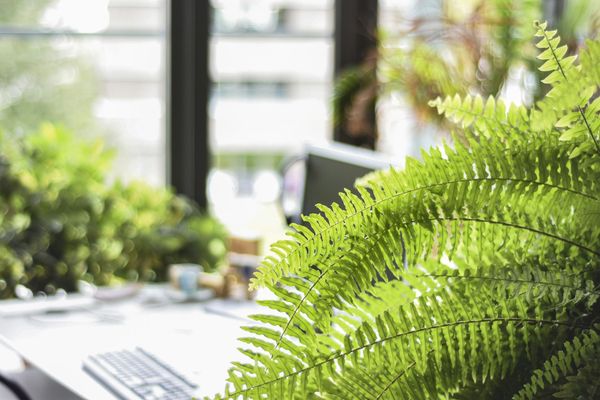Boston Fern Care Guide
How to grow and care for Boston Fern (Nephrolepis exaltata)
Welcome to the world of the Nephrolepis exaltata, commonly known as the Boston Fern! This lush, vibrant plant is coveted for its appealing, feathery fronds and ability to purify indoor air. With its elegant appearance, the Boston Fern is a popular choice for bringing a touch of the outdoors into your home. Whether you’re a seasoned plant enthusiast or a budding indoor gardener, this care guide will help ensure your Boston Fern thrives, filling your space with its distinctive greenery.

Disclosure: This content includes affiliate links, which means we may earn a commission if you click on a link and make a purchase. As an Amazon Associate, we earn from qualifying purchases. This comes at no extra cost to you and helps offset the cost of running Leafwise. Please read our disclaimer for more info.
Table of Contents
Care
Light
Boston Ferns thrive in bright, indirect light. Too much direct sunlight can scorch their fronds, while insufficient light may cause leggy, sparse growth. A north- or east-facing window or a spot with filtered light is ideal.
Humidity & Temperature
These ferns require high humidity to flourish. Aim for a humidity level of at least 50% by misting regularly, using a humidifier, or placing the pot on a humidity tray. Boston Ferns prefer temperatures between 60–75°F (16–24°C) and are sensitive to drafts and sudden temperature changes. Avoid placing them near heaters or air conditioners.
If outdoor temperatures fall below 55°F (13°C), bring your fern indoors. Choose a location with bright, indirect light and maintain high humidity. Reduce watering slightly during this period, keeping the soil evenly moist but not soggy. Check soil moisture by feeling the top inch—if it feels dry, it's time to water.
Watering
Keep the soil consistently moist but not waterlogged. Water thoroughly when the surface feels slightly dry, using lukewarm, filtered water to prevent shock. In winter, reduce watering slightly, but do not allow the soil to dry out completely.
Soil
Use a rich, well-draining potting mix that retains moisture without becoming compacted. A peat-based mix combined with perlite or bark provides ideal growing conditions.
Fertilization
During the growing season (spring and summer), feed monthly with a balanced liquid fertilizer diluted to half strength. Suspend feeding during the fall and winter months when growth slows.
Maintenance
Pruning
Regularly remove dead, yellowing, or browning fronds to maintain a neat appearance and promote healthy new growth.
Repotting
Repot every 2–3 years or when roots begin to grow through drainage holes. Choose a slightly larger container and refresh the soil to support continued development.
Rotation
Turn the plant occasionally to ensure all sides receive equal light, which promotes symmetrical growth.
Support
If fronds become long or begin to droop, provide structural support using a compact plant hoop, wire ring, or small trellis to help maintain the plant's shape.
Propagation
By Division
Boston Ferns are most commonly propagated by division:
- Remove the plant from its pot during repotting.
- Gently separate the root ball into smaller clumps, ensuring each division has healthy roots and fronds.
- Replant each division into its own pot with fresh potting mix.
- Water lightly and maintain high humidity and indirect light until new growth appears.
By Spores
Although more challenging and better suited to experienced growers, Boston Ferns can also be propagated from spores:
- Locate brownish spores on the undersides of mature fronds.
- Scrape the spores onto a moist, sterile growing medium such as peat moss.
- Cover with plastic to retain humidity and place in bright, indirect light.
- Germination may take several weeks. Keep the medium consistently moist until gametophytes and eventually true fronds appear.
Common Issues
Dry, Curled Leaves
- Cause: Low humidity or underwatering.
- Symptoms: Fronds become crisp or curl inward, especially at the tips.
- Solution: Increase humidity with a humidifier or pebble tray and water more frequently while keeping the soil evenly moist.
Brown Tips on Fronds
- Cause: Excess fertilizer or fluoride in tap water.
- Symptoms: Browning begins at the frond tips and may progress inward.
- Solution: Use distilled or filtered water and reduce fertilizer use. Flush the soil occasionally by watering until it drains freely to remove salt buildup.
Pests
- Common pests: Spider mites, mealybugs, scale insects.
- Symptoms: Fine webbing (spider mites), cottony white spots (mealybugs), or brown bumps (scale) on stems and fronds. Affected fronds may yellow or drop.
- Solution: Treat with neem oil or insecticidal soap. Reapply every few days as needed. Isolate the plant and increase humidity to discourage spider mites.
Yellowing Leaves
- Cause: Overwatering, poor drainage, low humidity, or excess fertilizer.
- Solution: Adjust watering habits, improve drainage, increase humidity, and flush the soil if salt buildup is suspected.
Fungal Diseases
- Cause: Overwatering or inadequate air circulation.
- Symptoms: Dark, mushy spots on fronds or stems.
- Solution: Improve airflow, avoid overhead watering, prune affected areas, and use a fungicide if necessary.
Final Tips
With consistent care, Boston Ferns reward growers with lush, feathery foliage that adds a refreshing tropical flair to indoor spaces. For best results, maintain high humidity, provide filtered light, avoid drafts, and regularly check soil moisture. Keeping a close eye on your fern’s environment will ensure it remains healthy and vibrant year-round.
